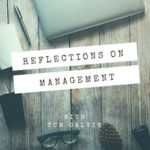
As we covered way back in Episode 9, Fritz Roethlisberger and William J. Dickson worked in support of Elton Mayo’s famed Hawthorne Studies that began as an investigation into what lighting conditions that would increase worker productivity. When that particular aim proved unsuccessful, Roethlisberger and Dickson continued a long series of experiments that tried to uncover what variables could the Western Electric Company tweak to achieve the desired increase. While the studies did not produce the silver-bullet solution hoped for, it would uncover the informal structure of the organization within which workers sought to control their own work environments in ways that often opposed the company’s desires, and in theory at least even opposed the individual economic aspirations of the workers themselves.
Roethlisberger and Dickson chronicled the five years of study in the 1939 book Management and the Worker which contained five parts. Part I detailed the design, conduct, and findings of three studies where five female workers from a single department were moved into a test room performing the same tasks under observation. The experiments were phased such that new conditions were introduced each about 4-7 weeks apart – such as the numbers and durations of breaks and the shortening and lengthening of the work weeks. The results were deemed surprising, contradictory, and ultimately disappointing that once again no such optimal conditions could be found. Meanwhile, the isolation of the workers from their departments introduced interpersonal tensions that heightened over time.
Parts II and III were introspective of the research effort and constituted a re-examination of the data to understand what the workers were communicating to the researchers. The focus was on building conceptual frameworks to understand worker complaints and dissatisfactions and how to interpret them. This ultimately informed the design of the most complex study conducted, of the Bank Wiring Department, detailed in Part IV.
In this final set of studies, a cross-department team of wiremen, solderers, inspectors, truckers, and others was isolated in a separate room for observation, interviews, and experiments in adjusting piecework payment plans. It was here that the researchers explored the social controls that workers exercised over each other that resulted in norms whereby no one would work harder or produce more than what was considered among the workers to be an appropriate “day’s work,” even though this amount was below what management demanded. The researchers also realized that the participants were stratified into two “cliques” that were physically separated within the room, with the senior clique doing the easier jobs and located in the prominent positions in the front of the room. The junior clique handled the tougher jobs, thereby producing less, complained more, and were relegated to the back of the room.
In the end, the book concluded that there were three organizational forms in the plant – the formal structure, the informal structure, and the ideological structure that mirrors current three-pillared institution theories (e.g., the regulative, normative, and cognitive pillars of W. Richard Scott (2014)). The informal and ideological structures operated differently from management intentions and therefore needed to be understood by management if it were to set conditions for optimal work performance. Moreover, Roethlisberger and Dickson recommended that leaders establish managerial positions dedicated to mastering the human conditions of the plant in order to identify and correct problems that caused worker dissatisfaction and distress. Sadly, these last recommendations have not been heeded over time.
Despite its length, Management and the Worker is a fascinating and important work that explored both the meaning of work and the challenges of studying it. While some aspects of the setting and conditions may be dated, the tensions and sources of dissatisfactions found in the workplace climate remain relevant today.
You may also download the audio files here: Part 1 | Part 2 | Supplement
Read with us:
Roethlisberger, F. J. & Dickson, W. J. (1939). Management and the worker. Cambridge, MA: Harvard University Press.
To know more:
Mayo, E. (1945). The Social Problems of an Industrial Civilization.

